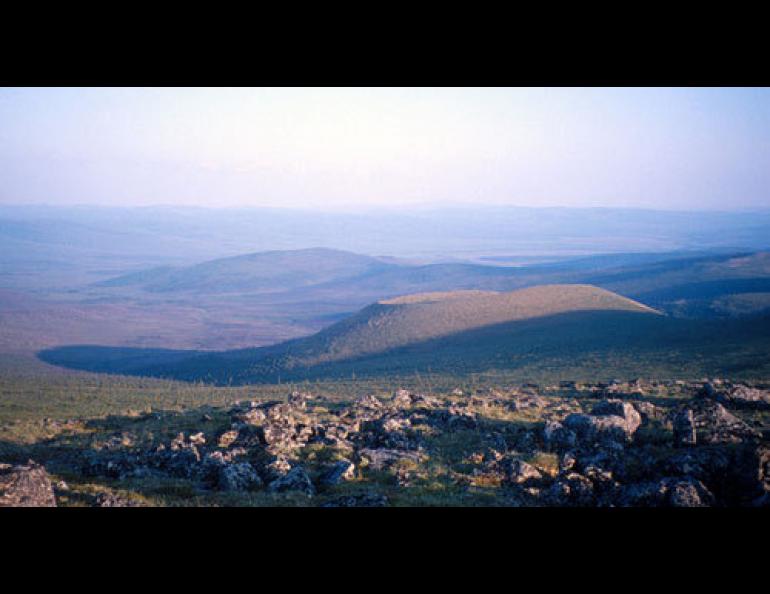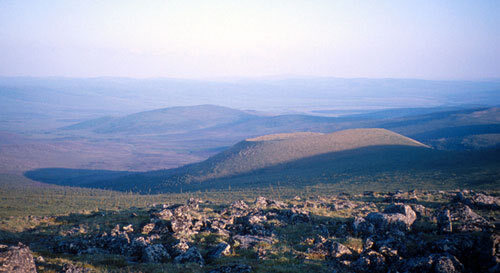
The loneliest volcano in Alaska
In 1905, Louis Prindle was a 40-year-old geologist bushwhacking through eastern Alaska when he stumbled upon a crater covered with spruce trees. He took a photo of the oddity and continued on his wilderness trek to map the Fortymile country.
Mount Prindle, named for Louis by another geologist, is one of the loneliest volcanoes in Alaska. While most of Alaska’s volcanoes make up the curve of the Aleutian Islands, with bunches of others on the Alaska Peninsula, in Cook Inlet, and in the Wrangell Mountains, Prindle stands alone in the Fortymile River country close to the Canada border, about 50 miles northeast of Tok.
Louis Prindle’s orders were to satisfy miners’ demands for maps of the upper Yukon and Tanana river regions. With hundreds of miles to cover before ending his summer expedition in Fairbanks, he didn’t spend much time exploring the stadium-size volcano tucked in the upper reaches of the East Fork River.
The volcano piqued the interest of others who followed Prindle, including JB Mertie, another U.S. Geological Survey geologist on a mapping mission. In 1931, Mertie wrote about “a little volcanic cone, with a well-developed crater, which . . . is so well preserved that it may well be of recent age.”
Mount Prindle has a sharp-edged crater about 200 feet deep and an open spout on one wall of the crater where lava flowed down to the valley floor of the East Fork River. Spruce trees grow inside the crater and tundra covers the outside wall of the volcano. It still looks like a young volcano, though. One that the boreal forest has not yet overtaken, and other geological forces have not yet bulldozed.
Helen Foster of the USGS was part of a team that traveled to the volcano in the 1960s. In an attempt to discover the date of Prindle’s last eruption, she noted a coating of volcanic ash that blanketed the crater. The ash, known as White River Ash, is from another volcano that erupted in the area about 1,900 years ago. From the ash coating and the dating of other rocks she collected at Mount Prindle, she estimated that the volcano was possibly several million years old, but might have last erupted around the birth of Christ.
In 1995, another group of scientists chartered a helicopter from Tok to study Mount Prindle. Ben Edwards of Dickinson College in Pennsylvania was then a graduate student interested in the volcano. Shortly after he and his party landed on the rim of the volcano, Edwards picked up some green and white rocks that make the volcano unique. The rocks, called xenoliths, are from deep within Earth’s mantle and crust, possibly more than 12 miles down. When molten rock raced to the surface during Prindle’s eruption, it picked up xenoliths along the way and shot them out as lava bombs that still rest on the surface around the volcano.
“We’d never get that information from drilling,” said Kelly Russell, Edwards’ colleague at the University of British Columbia. “Volcanoes like Prindle have erupted fast enough and vigorous enough to bring this stuff up.”
Mount Prindle belongs to a group of volcanoes in Canada called the Northern Cordilleran Volcanic Province, Edwards said. This band of dormant volcanoes extends from central British Columbia all the way up to the Yukon Territory and Prindle in Alaska.
Russell and Edwards think Prindle and other volcanoes in the group formed differently than Alaska’s active volcanoes, which sit above the subduction zone where the massive Pacific Plate is grinding beneath the North American Plate. Though Prindle is far from where the plates meet, the volcano is located in an area where Earth’s crust is stretched by the action of the plates, Edwards said. This stretching creates fractures that allow heat and molten rock to escape the inner Earth, erupt at the surface, and sometimes leave behind solitary cinder cones, such as Mount Prindle.




